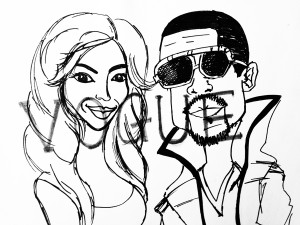Kim Kardashian Vogue cover reflects culture
I hate working out. It keeps me away from my happiest place: stuffing my face with mint chocolate chip ice cream. I do, however, subject myself to exercising at least three times per week, or at least that’s what I tell my physician to keep her happy. And usually while running on the treadmill, I turn on something I would usually consider trivial in a French salon, such as reality shows that transport me to a place where the biggest problems are if so-and-so throws a better party than her best frenemy or if a person’s picture has enough likes on Instagram. Lately, I’ve been watching a lot of Keeping Up with the Kardashians, a phenomenon so glaring that it has led Kim, who I deem the most prominent sister, and her other half, Kanye West, to land the cover of the newest edition of Vogue.
Before I had immersed myself in a world where everyone’s name started with a “K,” I rolled my eyes at the Kardashian clan. I didn’t understand the sudden fascination with a family who capitalized upon an invasion of their privacy. Kim has a net worth of more than $40 million, according to Huffington Post. This is a sum that is garnered from various sponsorships, a role in a Tyler Perry movie and a broadcasted wedding for a marriage that lasted 72 days. To illustrate the pull the show has on people, the Kardashian sisters have a combined total of more than 41 million followers on Twitter.
But now I understand the Kardashian pandemonium. I am a naturally curious person, so I am inclined to be interested in their extravagant lives. Watching the show, as scripted and feigned-suspenseful as it may be, provides me an escape from my mundane life. These explanations are what I expect to be reasons behind why masses of people find Keeping Up with the Kardashians so interesting. This is why I didn’t even bat an eye when the newest edition of Vogue was unleashed.
Social media users criticized the new cover of Vogue, with Twitter users threatening to cancel their subscriptions and Seth Rogen and James Franco photoshopping their faces in place of Kim and Kanye’s. Even Kermit the Frog and Miss Piggy joined in on the comic relief, posing for their spoof of Vogue, Vague. I can see why there has been backlash toward the cover. USA Today explains that until the late 1990s, only models graced the cover of Vogue. Since then, mostly actresses, singers and athletes have found their way onto the cover.
Vogue is the pinnacle embrace of high fashion, but there are obvious attempts within the magazine to reach out to the greater population. A lot of people appreciate high fashion, but not a lot of people can feel a connection to a size-0 model or an actress. Kim Kardashian’s presence is ubiquitous, and her cover allows us — or maybe just me — to feel like we’re a part of a bigger movement. For a universal concept such as appearance, to isolate certain people’s participation is ludicrous. Everyone can participate in the evolution of media this way because the reason we find certain people on the cover of certain magazines is due to the credit we give them.
Vogue’s new cover signifies an adaptation to the current social climate, something that is needed to foster a bridge between a secluded realm in fashion and the common person. I toast my bowl of mint chocolate chip ice cream to Anna Wintour, the fashion bible’s editor-in-chief, because this just might be high fashion’s answer to inclusiveness.
Danni Wang is a freshman majoring in psychology. Her column, “Pop Fiction,” runs Tuesdays.


